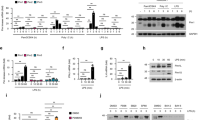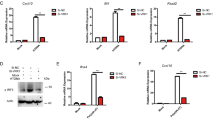Summary
Poly(ADP-ribose) polymerase 1 (PARP1) plays important roles in the regulation of transcription factors. Mounting evidence has shown that inhibition of PARP1 influences the expression of genes associated with inflammatory response. Interferon regulatory factor 1 (IRF1) is a critical transcription factor for the development of both the innate and adaptive immune responses against infections. However, the molecular mechanism through which PARP1 mediates the effects has not been clearly demonstrated. Jurkat cells were exposed to dexamethasone (Dex) or PARP1 inhibitor PJ34. The expression levels of IL-12, LMP2, OAS1 and PKR were detected using real-time RT-PCR. The interactions between PARP1 and IRF1 were examined by co-immunoprecipitation (co-IP) assays. We further explored the mechanism of PARP1 suppressing IRF1 by assessing the activities of interferon stimulated response element (ISRE). The mRNA expression of IL-12, LMP2, OAS1 and PKR was obviously suppressed by Dex in Jurkat cells, which could be rescued by PJ34 treatment. Luciferase study revealed that poly(ADP-ribosyl)- ation suppressed IRF1-mediated transcription through preventing the binding of IRF1 to ISREs. PARP1 inhibited IRF1-mediated transcription in Jurkat cells by preventing IRF1 binding to ISREs in the promoters of target genes. It is suggested that PARP1 is a crucial regulator of IRF1-mediated immune response. This study provides experimental evidence for the possible application of PARP1 inhibitors in the treatment of IRF1-related immune anergy.
Similar content being viewed by others
References
Reis LF, Harada H, Wolchok JD, et al. Critical role of a common transcription factor, IRF-1, in the regulation of IFN-beta and IFN-inducible genes. EMBO J, 1992, 11(1):185–193
Kano S, Sato K, Morishita Y, et al. The contribution of transcription factor IRF1 to the interferon-gamma-interleukin 12 signaling axis and TH1 versus TH- 17 differentiation of CD4+ T cells. Nat Immunol, 2008, 9(1):34–41
Brucet M, Marques L, Sebastian C, et al. Regulation of murine Tap1 and Lmp2 genes in macrophages by interferon gamma is mediated by STAT1 and IRF-1. Genes Immun, 2004, 5(1):26–35
Blair LA, Maggi LB Jr, Scarim AL, et al. Role of interferon regulatory factor-1 in double-stranded RNA-induced iNOS expression by mouse islets. J Biol Chem, 2002, 277(1):359–365
Chapin WJ, Lenkala D, Mai Y, et al. Peripheral blood IRF1 expression as a marker for glucocorticoid sensitivity. Pharmacogenet Genomics, 2015, 25(3):126–133
Franchimont D, Galon J, Gadina M, et al. Inhibition of Th1 immune response by glucocorticoids: dexamethasone selectively inhibits IL-12-induced Stat4 phosphorylation in T lymphocytes. J Immunol, 2000, 164(4):1768–1774
Nunez BS, Geng CD, Pedersen KB, et al. Interaction between the interferon signaling pathway and the human glucocorticoid receptor gene 1A promoter. Endocrinology, 2005, 146(3):1449–1457
Szabo C. Role of poly(ADP-ribose)synthetase in inflammation. Eur J Pharmacol, 1998, 350(1):1–19
Chiarugi A. Inhibitors of poly(ADP-ribose) polymerase-1 suppress transcriptional activation in lymphocytes and ameliorate autoimmune encephalomyelitis in rats. Br J Pharmacol, 2002, 137(6):761–770
Ha HC, Hester LD, Snyder SH. Poly(ADP-ribose) polymerase-1 dependence of stress-induced transcription factors and associated gene expression in glia. Proc Natl Acad Sci USA, 2002, 99(5):3270–3275
Huang D, Yang C, Wang Y, et al. PARP-1 suppresses adiponectin expression through poly(ADP-ribosyl)ation of PPAR gamma in cardiac fibroblasts. Cardiovasc Res, 2009, 81(1):98–107
Salkowski CA, Kopydlowski K, Blanco J, et al. IL-12 is dysregulated in macrophages from IRF-1 and IRF-2 knockout mice. J Immunol, 1999, 163(3):1529–1536
White LC, Wright KL, Felix NJ, et al. Regulation of LMP2 and TAP1 genes by IRF-1 explains the paucity of CD8+ T cells in IRF-1-/- mice. Immunity, 1996, 5(4):365–376
Ciccaglione AR, Stellacci E, Marcantonio C, et al. Repression of interferon regulatory factor 1 by hepatitis C virus core protein results in inhibition of antiviral and immunomodulatory genes. J Virol, 2007, 81(1):202–214
Taki S, Sato T, Ogasawara K, et al. Multistage regulation of Th1-type immune responses by the transcription factor IRF-1. Immunity, 1997, 6(6):673–679
Wang C, Zhang F, Wang L, et al. Poly(ADP-ribose) polymerase 1 promotes oxidative-stress-induced liver cell death via suppressing farnesoid X receptor alpha. Mol Cell Biol, 2013, 33(22):4492–4503
Yang L, Huang K, Li X, et al. Identification of poly(ADP-ribose) polymerase-1 as a cell cycle regulator through modulating Sp1 mediated transcription in human hepatoma cells. PLoS One, 2013,8(12):e82872
Sato M, Taniguchi T, Tanaka N. The interferon system and interferon regulatory factor transcription factors — studies from gene knockout mice. Cytokine Growth Factor Rev, 2001,12(2–3):133–142
Eroshkin A, Mushegian A. Conserved transactivation domain shared by interferon regulatory factors and Smad morphogens. J Mol Med (Berl), 1999, 77(5):403–405
Harikumar KB, Yester JW, Surace MJ, et al. K63- linked polyubiquitination of transcription factor IRF1 is essential for IL-1-induced production of chemokines CXCL10 and CCL5. Nat Immunol, 2014, 15(3):231–238
Kim EJ, Park JS, Um SJ. Ubc9-mediated sumoylation leads to transcriptional repression of IRF-1. Biochem Biophys Res Commun, 2008, 377(3):952–956
Yang H, Lee SM, Gao B, et al. Histone deacetylase sirtuin 1 deacetylates IRF1 protein and programs dendritic cells to control Th17 protein differentiation during autoimmune inflammation. J Biol Chem, 2013,288(52):37256–37266
Chatterjee-Kishore M, Wright KL, Ting JP, et al. How Stat1 mediates constitutive gene expression: a complex of unphosphorylated Stat1 and IRF1 supports transcription of the LMP2 gene. EMBO J, 2000, 19(15):4111–4122
Fujita T, Sakakibara J, Sudo Y, et al. Evidence for a nuclear factor(s), IRF-1, mediating induction and silencing properties to human IFN-beta gene regulatory elements. EMBO J, 1988, 7(11):3397–3405
Pine R, Decker T, Kessler DS, et al. Purification and cloning of interferon-stimulated gene factor 2 (ISGF2): ISGF2 (IRF-1) can bind to the promoters of both beta interferon- and interferon-stimulated genes but is not a primary transcriptional activator of either. Mol Cell Biol, 1990, 10(6):2448–2457
Martin E, Nathan C, Xie QW. Role of interferon regulatory factor 1 in induction of nitric oxide synthase. J Exp Med, 1994, 180(3):977–984
Kamijo R, Harada H, Matsuyama T, et al. Requirement for transcription factor IRF-1 in NO synthase induction in macrophages. Science, 1994, 263(5153):1612–1615
Remoli AL, Marsili G, Perrotti E, et al. Intracellular HIV- 1 Tat protein represses constitutive LMP2 transcription increasing proteasome activity by interfering with the binding of IRF-1 to STAT1. Biochem J, 2006, 396(2):371–380
Author information
Authors and Affiliations
Corresponding authors
Additional information
This work was supported by the National Natural Science Foundation of China (No. 81370263 and No. 81500348).
Rights and permissions
About this article
Cite this article
Wang, C., Du, M., Huang, D. et al. Inhibition of PARP1 Increases IRF-dependent Gene Transcription in Jurkat Cells. CURR MED SCI 39, 356–362 (2019). https://doi.org/10.1007/s11596-019-2043-1
Received:
Revised:
Published:
Issue Date:
DOI: https://doi.org/10.1007/s11596-019-2043-1




